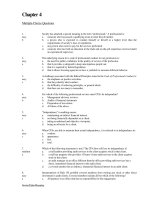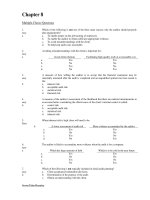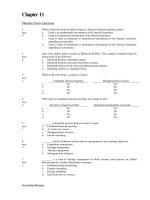Lecture Auditing and assurance services (Second international edition) Chapter 9 Audit sampling An application to substantive tests of account balances
Bạn đang xem bản rút gọn của tài liệu. Xem và tải ngay bản đầy đủ của tài liệu tại đây (946.43 KB, 50 trang )
Chapter Nine
Audit Sampling:
An Application to
Substantive Tests of
Account Balances
McGraw-Hill/Irwin
© The McGraw-Hill Companies 2010
Substantive Tests of Details of Account
Balances
The statistical concepts we discussed in the last
chapter apply to this chapter as well. Three important
determinants of sample size are:
1. Desired confidence level.
2. Tolerable misstatement.
3. Expected misstatement.
Population plays a bigger role in some of the sampling
techniques used for substantive testing.
Misstatements discovered in the audit sample must be
projected to the population, and there must be an
allowance for sampling risk.
McGraw-Hill/Irwin
© The McGraw-Hill Companies 2010
Substantive Tests of Details of Account
Balances
Consider the following information about the
inventory account balance of an audit client:
Book value of inventory account balance
Book value of items sampled
€ 3,000,000
€ 100,000
Audited value of items sampled
98,000
Total amount of overstatement observed in audit sample €
2,000
The ratio of misstatement in the sample is 2%
(€2,000 ÷ €100,000)
Applying the ratio to the entire population produces a
best
estimate of misstatement of inventory of €60,000.
(€3,000,000 × 2%)
McGraw-Hill/Irwin
© The McGraw-Hill Companies 2010
Substantive Tests of Details of Account
Balances
The results of our audit test depend
upon the tolerable misstatement
associated with the inventory account.
If the tolerable misstatement is
€50,000, we cannot conclude that the
account is fairly stated because our
best estimate of the projected
misstatement is greater than the
tolerable misstatement.
McGraw-Hill/Irwin
© The McGraw-Hill Companies 2010
Monetary-Unit Sampling (MUS)
MUS
MUS uses
uses attribute-sampling
attribute-sampling theory
theory to
to
express
express aa conclusion
conclusion in
in monetary
monetary amounts
amounts
(e.g.
(e.g. in
in euros
euros or
or other
other currency)
currency) rather
rather than
than
as
as aa rate
rate of
of occurrence.
occurrence. ItIt is
is commonly
commonly used
used
by
by auditors
auditors to
to test
test accounts
accounts such
such as
as accounts
accounts
receivable,
receivable, loans
loans receivable,
receivable, investment
investment
securities
securities and
and inventory.
inventory.
McGraw-Hill/Irwin
© The McGraw-Hill Companies 2010
Monetary-Unit Sampling (MUS)
MUS uses attribute-sampling theory
(used primarily to test controls) to
estimate the percentage of monetary
units in a population that might be
misstated and then multiplies this
percentage by an estimate of how
much the euros are misstated.
McGraw-Hill/Irwin
© The McGraw-Hill Companies 2010
Monetary-Unit Sampling (MUS)
Advantages of MUS
1. When the auditor expects no misstatement,
MUS usually results in a smaller sample size
than classical variables sampling.
2. The calculation of the sample size and
evaluation of the sample results are not
based on the variation between items in the
population.
3. When applied using the probabilityproportional-to-size procedure, MUS
automatically results in a stratified sample.
McGraw-Hill/Irwin
© The McGraw-Hill Companies 2010
Monetary-Unit Sampling (MUS)
Disadvantages of MUS
1. The selection of zero or negative balances
generally requires special design
consideration.
2. The general approach to MUS assumes that
the audited amount of the sample item is not
in error by more than 100%.
3. When more than one or two misstatements
are detected, the sample results calculations
may overstate the allowance for sampling
risk.
McGraw-Hill/Irwin
© The McGraw-Hill Companies 2010
Steps in MUS Sampling
McGraw-Hill/Irwin
© The McGraw-Hill Companies 2010
Steps in MUS Sampling
Sampling may be used for substantive testing to:
1. Test the reasonableness of assertions about a
financial statement amount (i.e. is the amount
fairly stated). This is the most common use of
sampling for substantive testing.
2. Develop an estimate of some amount.
McGraw-Hill/Irwin
© The McGraw-Hill Companies 2010
Steps in MUS Sampling
For MUS the population is defined as the
monetary value of an account balance,
such as accounts receivable, investment
securities or inventory.
McGraw-Hill/Irwin
© The McGraw-Hill Companies 2010
Steps in MUS Sampling
An individual euro represents the sampling unit.
McGraw-Hill/Irwin
© The McGraw-Hill Companies 2010
Steps in MUS Sampling
A misstatement is defined as the difference
between monetary amounts in the client’s
records and amounts supported by audit
evidence.
McGraw-Hill/Irwin
© The McGraw-Hill Companies 2010
Steps in MUS Sampling
McGraw-Hill/Irwin
© The McGraw-Hill Companies 2010
Steps in MUS Sampling
The auditor selects a sample for MUS by using a
systematic selection approach called probabilityproportionate-to-size selection. The sampling
interval can be determined by dividing the book
value of the population by the sample size. Each
individual euro in the population has an equal
chance of being selected and items or ‘logical
units’ greater than the interval will always be
selected.
McGraw-Hill/Irwin
© The McGraw-Hill Companies 2010
Steps in MUS Sampling
Assume a client’s book value of accounts receivable is €2,500,000, and
the auditor determined a sample size of 93. The sampling interval will
be €26,882 (€2,500,000 ÷ 93). The random number selected is €3,977
the auditor would select the following items for testing:
Account
1001 Ace Emergency Centre
1002 Admington Hospital
1003 Jess Base
1004 Good Hospital Corp.
1005 Jen Mara Corp.
1006 Axa Corp.
1007 Green River Mfg.
1008 Bead Hospital Centres
•
•
1213 Andrew Call Medical
1214 Lilly Health
1215 Janyne Ann Corp.
Total Accounts Receivable
McGraw-Hill/Irwin
Balance
€
2,350
15,495
945
21,893
3,968
32,549
2,246
11,860
•
•
26,945
1,023
€ 2,500,000
© The McGraw-Hill Companies 2010
Cumulative
Euros
€
2,350
17,845
18,780
40,673
44,641
77,190
79,436
91,306
•
•
2,472,032
2,498,977
€ 2,500,000
Sample
Item
€
3,977 (1)
30,859 (2)
57,741 (3)
84,623 (4)
•
•
2,477,121 (93)
€
3,977
26,882
€ 30,859
Steps in MUS Sampling
After the sample items have been
selected, the auditor conducts the
planned audit procedures on the
logical units containing the selected
euro sampling units.
McGraw-Hill/Irwin
© The McGraw-Hill Companies 2010
Steps in MUS Sampling
The misstatements detected in the
sample must be projected to the
population. Let’s look at the following
example:
Example Information
Book value
Tolerable misstatement
Sample size
Desired confidence level
Expected amount of misstatement
Sampling interval
McGraw-Hill/Irwin
© The McGraw-Hill Companies 2010
€ 2,500,000
€
125,000
93
95%
€
25,000
€
26,882
Steps in MUS Sampling
Basic Precision using the Table
If no misstatements are found in the sample, the
best estimate of the population misstatement
would be zero euros.
€26,882 × 3.0 = €80,646 upper misstatement limit
McGraw-Hill/Irwin
© The McGraw-Hill Companies 2010
Steps in MUS Sampling
Misstatements Detected
In the sample of 93 items the following misstatements
were found:
Customer
Good Hospital
Marva Medical Supply
Axa Corp.
Learn Heart Centres
Book Value
€
21,893
6,705
32,549
15,000
Audit Value
€
18,609
4,023
30,049
-
Difference
€
3,284
2,682
2,500
15,000
Tainting
Factor
15%
40%
NA
100%
Because the Axa balance of €32,549 is greater than the
interval of €26,882, no €sampling
risk is added.
Since all
3,284 ÷ €21,893
= 15%
the euros in the large accounts are audited, there is no
sampling risk associated with large accounts.
McGraw-Hill/Irwin
© The McGraw-Hill Companies 2010
Steps in MUS Sampling
Compute the Upper Misstatement Limit
We compute the upper misstatement limit by calculating
basic precision and ranking the detected misstatements
based on the size of the tainting factor from the largest to
the smallest.
Tainting Sample Projected 95% Upper
Upper
Customer
Factor Interval Misstatement
Limit Misstatement
Basic Precision
1.00 € 26,882
NA
3.0
€ 80,646
Learn Heart Centres
1.00
26,882
26,882 1.7 (4.7 - 3.0)
45,700
Marva Medical
0.40
26,882
10,753 1.5 (6.2 - 4.7)
16,130
5,645
Good Hospital
0.15
26,882
4,032 1.4 (7.6 - 6.2)
Add misstatments greater
that the sampling interval:
2,500
Axa Corp.
NA
26,882
NA
Upper Misstatement Limit
€ 150,621
(0.15 × €26,882 × 1.4 = €5,645)
McGraw-Hill/Irwin
© The McGraw-Hill Companies 2010
Steps in MUS Sampling
In our example, the final decision is
whether the accounts receivable balance
is materially misstated or not.
We compare the tolerable misstatement to the upper
misstatement limit. If the upper misstatement limit is
less than or equal to the tolerable misstatement, we
conclude that the balance is not materially misstated.
McGraw-Hill/Irwin
© The McGraw-Hill Companies 2010
Steps in MUS Sampling
In our example the upper misstatement limit of €150,621 is
greater than the tolerable misstatement of €125,000, so
the auditor concludes that the accounts receivable balance
is materially misstated.
When faced with this situation, the auditor may:
1. Increase the sample size.
2. Perform other substantive procedures.
3. Request the client adjust the accounts receivable balance.
4. If the client refuses to adjust the account balance, the
auditor would consider issuing a qualified or adverse
opinion.
McGraw-Hill/Irwin
© The McGraw-Hill Companies 2010
Risk When Evaluating
Account Balances
McGraw-Hill/Irwin
© The McGraw-Hill Companies 2010
Effect of Understatement Misstatements
MUS is not particularly effective at detecting
understatements. An understated account is less
likely to be selected than an overstated account.
Book
Customer
Value
Wayne County Medical € 2,000
Audit
Value
€ 2,200
Difference
€
(200)
Tainting
Factor
-10%
The most likely error will be reduced by €2,688
(– 0.10 × €26,882)
McGraw-Hill/Irwin
© The McGraw-Hill Companies 2010









